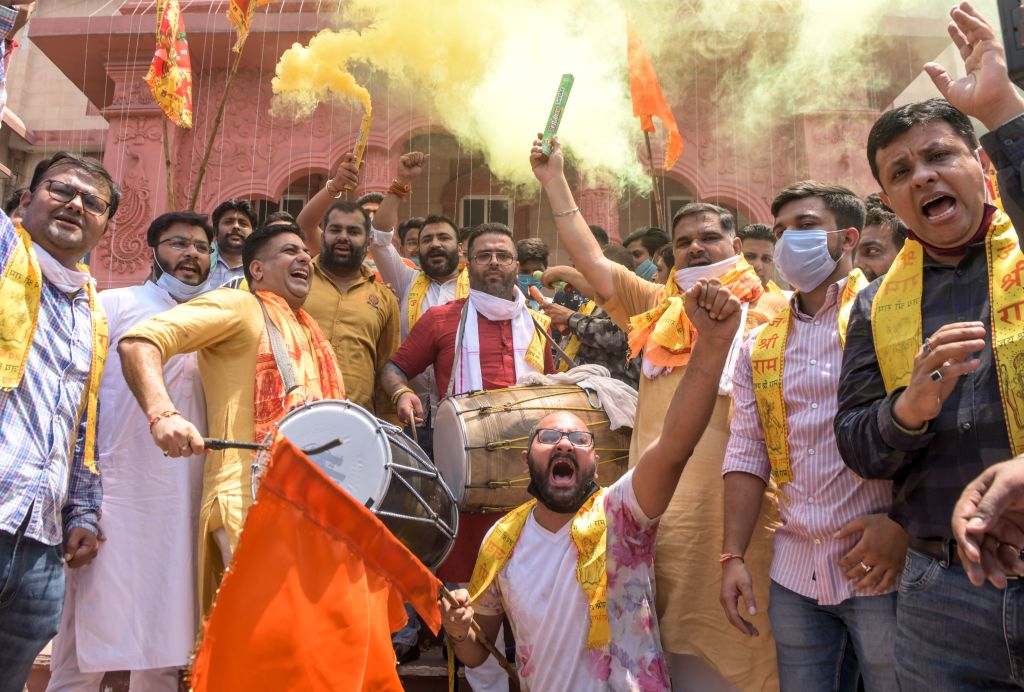
As India prepares to celebrate the 73rd anniversary of its independence on 15 August, a growing number of Indians are coming to believe that the battle to preserve the essence of the country born in 1947 is already lost. Many commentators have concluded that Prime Minister Narendra Modi’s government has already, in effect, inaugurated a ‘second republic’ by upending the key assumptions of the first.
According to these despairing analysts, this ‘refounding’ began on 5 August 2019, when Article 370 of the Indian constitution was abrogated and Jammu and Kashmir was stripped of its autonomy, and was completed in Ayodhya earlier this month, exactly one year later. There, in an hours-long grand ceremony televised to adoring millions, Modi performed a bhoomi poojan (worship of the earth) and laid a 40-kilogram silver brick into the foundation of a future temple to the Hindu god Rama, on the site of the demolished Babri mosque.
Even before the construction of the temple had begun, this ceremony (and Modi’s participation in it) set the seal on the grand Hindutva project of Modi’s Bharatiya Janata Party (BJP). Many feared that India, which from its foundation has been a secular state, had turned a corner to becoming a Hindu Rashtra, a state of and for its Hindu majority.
From the moment of its electoral victory in 2014, Modi’s government embarked on its project of transforming the polity, consolidating its hold on the state machinery during its first term. Meanwhile, it sought to keep its supporters mobilised through reconversion to the mother faith, vigilantism and lynching of non-Hindus for supposed transgressions against cows, and outrage over minority appeasement and the allegedly anti-national statements and actions of dissenters, ranging from students to secularists, Kashmiris and Pakistani terrorists.
With the groundwork laid, BJP’s bigger electoral victory of 2019 launched the next stage of the national project. It started with the criminalisation of the Muslim divorce practice known as triple talaq (an unmistakable warning shot across the bow of the Muslim community). It continued with the stripping of Jammu and Kashmir’s autonomy (a clear signal that constitutional assurances were also up for grabs and that federalism could be overridden) and the passage of the amendment to the Citizenship Act (a direct challenge to the secular, non-religious assumptions of the constitution).
Next came the temple in Ayodhya, by which Modi’s government signalled that it was dismantling another relic of the first republic—interfaith accommodation. As the political scientist Suhas Palshikar put it, ‘The [Supreme Court] ruling in the Ayodhya case, ordering that Muslims be given an “alternative” site, formalised the peripheralisation of the Muslims both spatially and politically, while the celebrations openly involving state machinery underscore the officialisation of the status of Hindu religion as the basis of the new republic.’ If secularism, pluralism and diversity had been the catechism of the first republic, the BJP’s Hindutva is the liturgy of the second.
The BJP has been able to do all this because it has the necessary legislative majority. But, as Palshikar points out, it has gone well beyond such formalities with ‘the transformation of the Indian state into a repository of repression’ through ‘a politicised and poisonous administration—particularly in the case of the enforcement and investigation machineries’. Since 2014, the government has delegitimised dissent and criticism as hostile to the national interest, and every liberal thought and contrarian idea as undermining national pride and unity. The equation of opposition to the government—indeed, of liberal democracy itself—with ‘anti-national’ behaviour has inevitably followed.
There has clearly been a failure on the part of India’s independent institutions—the judiciary, opposition political parties, the media, the Election Commission and universities—to stanch the tide of militant majoritarianism. The Supreme Court’s Ayodhya judgement, condemning the destruction of the mosque but nonetheless awarding the disputed site to Hindus, was in many ways emblematic of the judiciary’s complicity in enabling this surrender.
In many other cases, the court has obligingly declined to hear challenges to government actions (including on habeas corpus petitions, the constitutionality of the Article 370 abrogation and the detention of political leaders) or acquiesced in them (like the prolonged internet cut-off in Kashmir) with scarcely a murmur. The opposition, while articulate, particularly on social media, has been widely, if not always fairly, derided for its tameness. It has also been divided—sometimes even within parties—on such vital issues as Kashmir and Ayodhya.
But the battle to define the Indian state is not yet over. Today, the ideals of India’s founders are challenged not only by Modi and the BJP, who prefer their idea of India as a Hindu Rashtra to the diversity and pluralism enshrined in the constitution. They are also contested by stone-throwing youths in the streets of Srinagar, Jammu and Kashmir’s largest city, and rifle-wielding Maoists in the forests of Chhattisgarh. A narrow-minded, sectarian India will never appeal to these alienated young people. Only an India that ensures full rights and dignity for all—the promise of liberal democracy—can do that.
Over the past six years, the votaries of Hindu nationalism have savoured the illusion of victory, but the struggle for India’s soul is still being waged. A divided India—the India of 5 August—can never fulfill the promise of the united India of 15 August. To succeed in the 21st century, India must remain faithful to its founding values.

